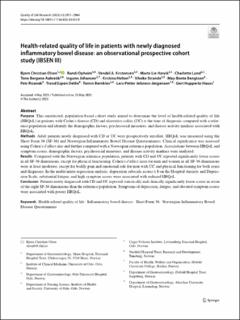| dc.contributor.author | Olsen, Bjørn Christian Elias Grova | |
| dc.contributor.author | Opheim, Randi | |
| dc.contributor.author | Kristensen, Vendel A. | |
| dc.contributor.author | Høivik, Marte Lie | |
| dc.contributor.author | Lund, Charlotte | |
| dc.contributor.author | Aabrekk, Tone Bergene | |
| dc.contributor.author | Johansen, Ingunn | |
| dc.contributor.author | Holten, Kristina | |
| dc.contributor.author | Strande, Vibeke | |
| dc.contributor.author | Bengtson, May-Bente | |
| dc.contributor.author | Ricanek, Petr | |
| dc.contributor.author | Detlie, Trond Espen | |
| dc.contributor.author | Bernklev, Tomm | |
| dc.contributor.author | Jelsness-Jørgensen, Lars-Petter | |
| dc.contributor.author | Huppertz-Hauss, Gert | |
| dc.date.accessioned | 2024-02-14T16:55:20Z | |
| dc.date.available | 2024-02-14T16:55:20Z | |
| dc.date.created | 2023-05-26T11:52:53Z | |
| dc.date.issued | 2023 | |
| dc.identifier.citation | Quality of Life Research. 2023, 32 (10), 2951-2964. | en_US |
| dc.identifier.issn | 0962-9343 | |
| dc.identifier.uri | https://hdl.handle.net/11250/3117798 | |
| dc.description.abstract | Purpose
This unselected, population-based cohort study aimed to determine the level of health-related quality of life (HRQoL) in patients with Crohn’s disease (CD) and ulcerative colitis (UC) at the time of diagnosis compared with a reference population and identify the demographic factors, psychosocial measures, and disease activity markers associated with HRQoL.
Methods
Adult patients newly diagnosed with CD or UC were prospectively enrolled. HRQoL was measured using the Short Form 36 (SF-36) and Norwegian Inflammatory Bowel Disease Questionnaires. Clinical significance was assessed using Cohen’s d effect size and further compared with a Norwegian reference population. Associations between HRQoL and symptom scores, demographic factors, psychosocial measures, and disease activity markers were analyzed.
Results
Compared with the Norwegian reference population, patients with CD and UC reported significantly lower scores in all SF-36 dimensions, except for physical functioning. Cohen’s d effect sizes for men and women in all SF-36 dimensions were at least moderate, except for bodily pain and emotional role for men with UC and physical functioning for both sexes and diagnoses. In the multivariate regression analysis, depression subscale scores ≥ 8 on the Hospital Anxiety and Depression Scale, substantial fatigue, and high symptom scores were associated with reduced HRQoL.
Conclusion
Patients newly diagnosed with CD and UC reported statistically and clinically significantly lower scores in seven of the eight SF-36 dimensions than the reference population. Symptoms of depression, fatigue, and elevated symptom scores were associated with poorer HRQoL. | en_US |
| dc.language.iso | eng | en_US |
| dc.publisher | Springer Nature | en_US |
| dc.rights | Navngivelse 4.0 Internasjonal | * |
| dc.rights.uri | http://creativecommons.org/licenses/by/4.0/deed.no | * |
| dc.subject | health-related quality of life | en_US |
| dc.subject | infammatory bowel disease | en_US |
| dc.subject | short Form 36 | en_US |
| dc.subject | Norwegian Infammatory Bowel Disease Questionnaire | en_US |
| dc.title | Health-related quality of life in patients with newly diagnosed inflammatory bowel disease: an observational prospective cohort study (IBSEN III) | en_US |
| dc.type | Peer reviewed | en_US |
| dc.type | Journal article | en_US |
| dc.description.version | publishedVersion | en_US |
| dc.rights.holder | © The Author(s) 2023. | en_US |
| dc.subject.nsi | VDP::Medisinske Fag: 700::Klinisk medisinske fag: 750::Nevrologi: 752 | en_US |
| dc.source.pagenumber | 2951-2964 | en_US |
| dc.source.volume | 32 | en_US |
| dc.source.journal | Quality of Life Research | en_US |
| dc.source.issue | 10 | en_US |
| dc.identifier.doi | 10.1007/s11136-023-03435-9 | |
| dc.identifier.cristin | 2149552 | |
| cristin.ispublished | true | |
| cristin.fulltext | original | |
| cristin.qualitycode | 2 | |

